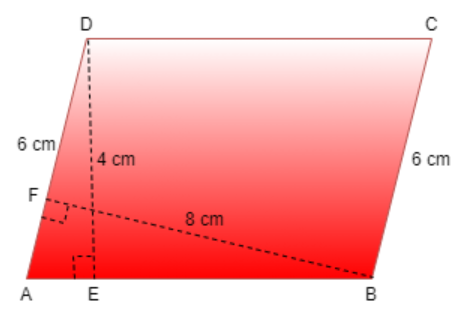
Answer
465k+ views
Hint: In this question remember to read the given information to identify the given dimensions and remember that area of a parallelogram is given as; base $ \times $ corresponding height, using this information will help you to approach the solution.
Complete step-by-step solution:
According to the given information we have DE = 4 cm, BF = 8 cm and AD = 6 cm
Using the formula of area of parallelogram i.e. base $ \times $ corresponding height
Now for parallelogram ABCD
Area of parallelogram ABCD taking AD as base = AD $ \times $ BF
Substituting the given values in the above equation we get
Area of parallelogram ABCD with base AD = 6 $ \times $ 8
Area of parallelogram ABCD with base AD = 48 $c{m^2}$
Now area of parallelogram ABCD taking base AB = AB $ \times $ DE
Substituting the given values in the above equation we get
Area of parallelogram ABCD with base AB = AB $ \times $ 4
Since we know that area of parallelogram ABCD with base AD = area of parallelogram ABCD with base AB
So, 48 = AB $ \times $ 4
$ \Rightarrow $ AB = $\dfrac{{48}}{4}$
$AB = 12 cm$
Now using the formula of perimeter of parallelogram ABCD = 2 (base length + side length)
So, perimeter of parallelogram $ABCD = 2 (AB + AD) $
Substituting the given values in the above formula we get
Perimeter of the parallelogram $ABCD = 2 (12 + 6) $
Perimeter of the parallelogram ABCD = 2 $ \times $ 18 = 36 cm
So, the perimeter of the parallelogram ABCD is 36 cm.
Note: In the above solution the term parallelogram which can be defined as the shape which is a quadrilateral with sides opposite and parallel to each other due to which opposite angles are also equal to each other. The parallelogram which consists of all right angles is called a rectangle and the parallelogram whose all sides are equal to each other is called a rhombus.
Complete step-by-step solution:
According to the given information we have DE = 4 cm, BF = 8 cm and AD = 6 cm
Using the formula of area of parallelogram i.e. base $ \times $ corresponding height
Now for parallelogram ABCD
Area of parallelogram ABCD taking AD as base = AD $ \times $ BF
Substituting the given values in the above equation we get
Area of parallelogram ABCD with base AD = 6 $ \times $ 8
Area of parallelogram ABCD with base AD = 48 $c{m^2}$
Now area of parallelogram ABCD taking base AB = AB $ \times $ DE
Substituting the given values in the above equation we get
Area of parallelogram ABCD with base AB = AB $ \times $ 4
Since we know that area of parallelogram ABCD with base AD = area of parallelogram ABCD with base AB
So, 48 = AB $ \times $ 4
$ \Rightarrow $ AB = $\dfrac{{48}}{4}$
$AB = 12 cm$
Now using the formula of perimeter of parallelogram ABCD = 2 (base length + side length)
So, perimeter of parallelogram $ABCD = 2 (AB + AD) $
Substituting the given values in the above formula we get
Perimeter of the parallelogram $ABCD = 2 (12 + 6) $
Perimeter of the parallelogram ABCD = 2 $ \times $ 18 = 36 cm
So, the perimeter of the parallelogram ABCD is 36 cm.
Note: In the above solution the term parallelogram which can be defined as the shape which is a quadrilateral with sides opposite and parallel to each other due to which opposite angles are also equal to each other. The parallelogram which consists of all right angles is called a rectangle and the parallelogram whose all sides are equal to each other is called a rhombus.
Recently Updated Pages
How is abiogenesis theory disproved experimentally class 12 biology CBSE

What is Biological Magnification

Class 9 Question and Answer - Your Ultimate Solutions Guide

Master Class 9 Science: Engaging Questions & Answers for Success

Master Class 9 English: Engaging Questions & Answers for Success

Glycerol can be separated from spentlye in soap industry class 9 chemistry CBSE

Trending doubts
Fill the blanks with the suitable prepositions 1 The class 9 english CBSE

How do you graph the function fx 4x class 9 maths CBSE

Distinguish between the following Ferrous and nonferrous class 9 social science CBSE

What is pollution? How many types of pollution? Define it

Voters list is known as A Ticket B Nomination form class 9 social science CBSE

Which places in India experience sunrise first and class 9 social science CBSE





